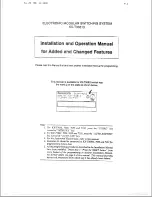
©2000 Motorola, Inc.
Cellular Overview
Service Manual
13
Power Steps
As a call progresses, the cell site continuously
monitors the reverse channel for signal
strength.
Every cellular telephone has a number of
power steps ranging from full power (3 watts
in a mobile and .6 watts in a portable) down
to as low as about half a milliwatt. In real-
ity all cellular telephones have eight power
steps, but portable models are prevented from
using the two highest power steps by the cell
site. Transmit power level commands are
sent to the cellular telephone as required to
maintain the received signal strength within
prescribed limits.
This is done to minimize interference possi-
bilities within the frequency re-use scheme.
If the signal received from the cellular tele-
phone is higher than the prescribed limit
(such as when the unit is very near the cell
site), the subscriber unit will be instructed
to step down to a lower level.
Hand-offs
If the cellular telephone is at its maximum
allowed power for the cell site it is using and
the received signal at the cell site is approach-
ing the minimum allowable (typically -100
dBm), the cell site will signal the switch to
consider the subscriber unit for a hand-off.
The central controller (switch) will in turn
have a scanning receiver at each of the sur-
rounding cell sites measure the cellular
telephone’s signal strength. The site with
the strongest signal will be the site to which
the call will be handed to if there are avail-
able voice channels.
On an AMPS channel the hand-off is executed
by interrupting the conversation with a burst
of data (called blank and burst) containing
the new voice channel assignment. The tele-
phone acknowledges the order by a 50 milli-
second burst of 10 kHz signaling tone on the
originally assigned voice channel. The mo-
bile telephone then drops the original voice
channel and tunes to the newly assigned voice
channel, keying up on that channel and
transponding the assigned SAT. But on a
NAMPS channel the hand-off is executed
with a low speed data transmission that does
not interrupt the voice. The telephone ac-
knowledges the order in this case by a DST
message. In either case, once the hand-off
has been accomplished, the newly assigned
cell site then alerts the switch that the hand-
off has been completed, and the old voice
channel is dropped.
It should be noted that this data exchange
happens very quickly, lasting only as long as
260 milliseconds. However, when data or
signaling tones are transmitted, audio is
muted for the duration of that transmission
and a syllable or two may be dropped from
conversation. This is normally not a prob-
lem, but during data signaling, such as that
employed for telefacsimile, answering ma-
chine, and computer communications, signifi-
cant amounts of information may be lost. For
this reason it is recommended that when
THE Cellular Connection™ equipment is
used the vehicle should be stationary to avoid
data loss during hand-offs and other data
transmissions. Otherwise the equipment
should employ an error correction protocol.
Analog Cellular
Summary of Contents for T2290
Page 1: ...DIGITAL WIRELESS TELEPHONE Service Manual Level 3 Release 1 TDMA T2290 T2297 ...
Page 26: ... 2000 Motorola Inc TDMA T2290 T2297 Cellular Overview 16 ...
Page 40: ...Motorola Confidential Proprietary TDMA T2290 T2297 TDMA Test Mode NAM Programming 30 ...
Page 68: ...Disassembly TDMA T2290 T2297 Keypad Removal Motorola Confidential Proprietary 58 ...
















































